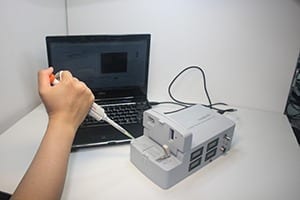
A portable instrument that replaces a full-size laboratory provides accurate multi-element analysis in less than a minute
Engineers from the A*STAR Institute of Materials Research and Engineering and colleagues at the University of Basel, Switzerland, have designed and developed a compact, portable analytical instrument that can detect multiple ions and molecules down to a level of 300 parts per billion (ppb) in less than a minute. The machine, based on lab-on-a-chip technology, needs only drop-sized liquid samples. The analysis is very quick, precise and sensitive, and can be performed remotely as no direct contact with the solution is necessary. As such, the device has widespread potential applications in the water, food and beverage, agriculture, environmental, pharmaceutical and medical industries.
“The instrument is now ready for commercialization,” says Kambiz Ansari, who led the research. “In this well-studied field, it is one of only a handful of actual lab-on-a-chip instruments reported so far.”
The easy-to-operate machine, which weighs only 1.2 kg, combines microchip electrophoresis (MCE) with a sensing technology known as a dual capacitively-coupled contactless conductivity detector (dC4D). The system first uses electrophoresis to separate ions and then detects the ions using dC4D. All analyses are performed in microfluidic channels consisting of capillaries inside polycarbonate plastic chips that are narrower than a human hair.
The beauty of the dC4D technology is its simplicity: it relies on remote conductivity measurements via a pair of electrodes. One electrode sends radio-frequency signals through a channel to the second electrode, and the signal received is read by a computer. Because the ions have charge, their resistance drops as they pass through the microfluidic channel, resulting in sudden peaks. Specially designed software then analyzes the data to provide both qualitative and quantitative information.
The Latest on: Lab-on-a-chip
[google_news title=”” keyword=”Lab-on-a-chip” num_posts=”10″ blurb_length=”0″ show_thumb=”left”]
via Google News
The Latest on: Lab-on-a-chip
- Aberdeen firm lands six-figure contract with global energy giant to develop oil monitoring systemon April 30, 2024 at 2:53 am
This award validates the efforts and success of over two years of research and development by our talented team.” ...
- RAB Microfluidics secures contract with global energy gianton April 30, 2024 at 12:04 am
RAB Microfluidics has secured a £750,000 contract with a global energy giant to develop an autonomous oil monitoring system for two-stroke marine vessel engines, based on its patented ‘lab-on-a-chip’ ...
- Researchers develop tiny droplets that harness laser light to detect disease markerson April 29, 2024 at 7:19 am
A team of researchers led by Nanyang Technological University, Singapore (NTU Singapore) has created tiny droplets that, when activated by laser light, can detect viral protein biomarkers indicating ...
- New diagnostic tool achieves accuracy of PCR tests with faster and simpler nanopore systemon April 17, 2024 at 7:56 pm
A new diagnostic tool developed by researchers can test for SARS-CoV-2 and Zika virus with the same or better accuracy as high-precision PCR tests in a matter of hours.
- Mini brains and lab-on-a-chip wearables: Jumar Bioincubator officially begins its mission to build "Australia's next CSL"on April 17, 2024 at 5:00 pm
Ovulation bio-sensing startup Symex Labs has developed a wearable "lab-on-a-chip" solution that provides continuous "set-and-forget" monitoring of hormones to more conveniently and effectively ...
- Mini brains and lab-on-a-chip wearables: Jumar Bioincubator officially begins its mission to build "Australia's next CSL"on April 17, 2024 at 7:00 am
Australia's newest biotech incubator Jumar Bioincubator has officially opened its doors and revealed the first 16 innovative early-stage ventures to take up residency in its much-awaited ...
- An Introduction to Lab-on-a-Chip Technology in Clinical Diagnostics: Successes and Remaining Challengeson March 26, 2024 at 12:00 am
Lab-on-a-chip platforms enable advanced processing, manipulation, and analysis of biological samples in miniaturized fluidic devices. Despite the numerous advantages, such as lower reagent and sample ...
- Heart-on-a-chip: A microfluidic marvel shaping the future of cardiovascular researchon February 6, 2024 at 10:38 am
The NIST team's results were published in Lab on a Chip. The HoC is a device that mimics the intricate interactions of cells within the heart on a small chip and is part of the larger organ-on-a ...
- Lab on a Chip News and Researchon November 1, 2023 at 5:00 pm
Researchers described the development and applications of a 3D-printed lab-on-a-chip device that quickly detected the presence of SARS-CoV-2 in patient's saliva. A University of Texas at Arlington ...
- New approach to complete automation in sizing and quantitation of DNA and proteins by the Automated Lab-on-a-Chip Platform from Agilent Technologieson October 25, 2022 at 9:48 am
The newly introduced Agilent 5100 Automated Lab-on-a-Chip Platform (ALP) offers a high-throughput system to overcome the limitations of slab gel analysis in protein and DNA sizing and quantitation.
via Bing News










